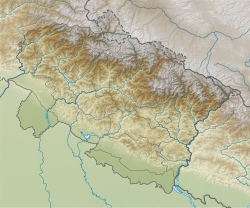| Nagalaphu | |
|---|---|
 | |
| Highest point | |
| Elevation | 6,410 m (21,030 ft) |
| Prominence | 440 m (1,440 ft) |
| Listing | List of mountains in India |
| Coordinates | 30°14′24″N80°25′48″E / 30.24000°N 80.43000°E |
| Geography | |
| Location | Pithoragarh, Uttarakhand, India |
| Parent range | Kumaon Himalaya |
Nagalaphu is a Himalayan mountain peak located in the Pithoragarh district of Uttarakhand state in India. [1]


